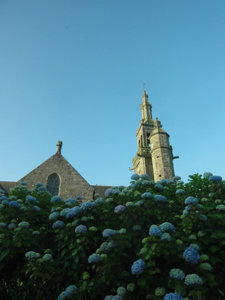Advertisement
Published: July 29th 2013

 Reminder of the Azores
Reminder of the Azores
We were reminded of the Azores with the amount of blue hydrangeas we have seen here.Our original plan had been to sail across the Bay of Biscay and arrive southeast of where we are currently located. Unfortunately we had spent so much time waiting for good weather in Spain that we decided we needed to move along if we were ever going to make it to Holland this season. We decided if we could not sail to these areas we would grab a bus and do some overland traveling. Our first trip was to a town called Quimper. Not sure what to expect, we took the approximately one hour bus ride and got off at the top of the town. We arrived there quite early, 8 AM (we found the French are not what one would call morning people) and the town was very quiet. Thinking we’d stop for a coffee we are amazed to find all the shops closed. It turned out to be an excellent time to get there because none of the tourists had arrived so the streets were almost completely deserted – a nice time to walk through the historic area of town. Quimper is a very old city that was left undamaged by the war. I have to remember to specify

 Farming with a view
Farming with a view
On the bus trip to Quimper we saw that there was an abundance of farm land – just this one was bordered by the ocean!World War II because they have been so many wars fought in this area. Many of the buildings in town date back to the 1400’s and the construction techniques look very similar to what I would’ve expected to see in England. In the center of town is a large Gothic cathedral, St-Corentin which is in excellent condition and a stunning example of what Gothic architecture is all about. Up to this point all the churches we have seen in France are small, simple chapels with very ornate stone carvings. This church is a “Cathedral” with its flying buttresses, incredibly ornate stained-glass windows, soaring pointed arches and magnificent paintings. Connected to the Cathedral was the bishops home which has been turned into a museum focusing specifically on the history of Brittany. The Museum does a very nice job explaining the history and also has an excellent collection of clothing from this area. Traditionally each region of Brittany had its own type of dress and head covering for both men and women. Some of these were extremely elaborate and are often pictured in postcards.
We took a walk along the river and came across another church that was probably one of

 Historic Area
Historic Area
A view of one of the streets in the historic area of town.the best examples of Romanesque architecture we’d ever seen, Eglise de Locmaria. It’s exterior was very simple and inside the arches were curved with few windows and almost no colored glass. It was nice to be able to compare these two styles so close together.
The reason the town is here is because of a large river that flows through it and joins to the sea a few miles from town, in fact the work Quimper means confluence. In earlier times ships would sail up the river during high tide to deliver and pick up supplies. Because of the topography of this area deep water ports are few and far between, therefore rivers became critically important accesses to the sea. In an area with a 20 foot tide ships were able to move up the river considerable distances thus making them less vulnerable to weather and piracy. Quimper was a walled city initially and if you look carefully you can still observe places where the wall is still intact.
Nowadays the river has silted in quite a bit and there are several small footbridges that cross it. Each of these bridges is beautifully lined with flower boxes. Our

 Breton Museum
Breton Museum
The Breton museum was housed next door to the Cathedral in what had been the bishop’s home.visit was for only one day but the town was well worth the trip.
Advertisement
Tot: 0.083s; Tpl: 0.016s; cc: 10; qc: 31; dbt: 0.0458s; 1; m:domysql w:travelblog (10.17.0.13); sld: 1;
; mem: 1.1mb

 Reminder of the Azores
Reminder of the Azores
 Farming with a view
Farming with a view
 Historic Area
Historic Area
 Breton Museum
Breton Museum
































